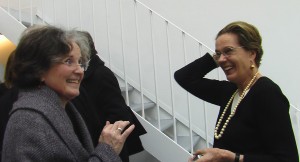Story Behind the Picture: Unintended Consequences from a Gathering of the Russian Intelligentsia
When the subjects of this photograph posed for the camera, they likely never imagined that the resulting picture would ultimately lead to grave consequences for one of them.

Tucker with Martine Frank, 2006 © Suzie Katz
Listen to Anne Tucker discuss the Photograph and its consequences:
The portrait shows a group of distinguished individuals — "the intellectual core of revolutionary Russia," says Anne Wilkes Tucker, curator of photography at The Museum of Fine Arts, Houston. They are gathered for a friendly salon in Moscow to discuss literature, art, and other topics of the day. This influential group of men and women — members of the Russian Futurism and Constructivism movements — advocated breaking from traditional Russian styles of art and literature, championing the fresh and avant-garde as part of the Russian Revolution.
But they didn’t just talk about it — their strongly held beliefs continually bubbled forth in their work. The group, for example, includes Russia’s first great filmmaker, Sergei Eisenstein, a wildly innovative artist who theorized and developed the montage, a technique that juxtaposes two seemingly unrelated images to create a new idea.
Two renowned Russian writers also attended the gathering — Boris Pasternak, the poet who received a Nobel Prize for his novel Doctor Zhivago, and the towering Vladimir Mayakovsky, a leading poet of the Russian Revolution and one of the founders of Russian Futurism.
Mayakovsky was a one-time lover of Lilya Brik (who stands just before him), an active member of intellectual circles who was married to Russian writer and literary critic Osip Brik. Lilya’s arm is gently entwined in friendship with that of Olga Tretyakova, the wife of the famous art critic and writer Sergei Tretyakov.
And standing amongst this group of notable Russian thinkers is the Japanese writer Tamiji Naito, whose appearance in the photo would ultimately be used to support trumped-up charges against one of his Russian friends.
“Olga Tretyakova was later sentenced to prison for being in this picture with Naito,” says Anne Wilkes Tucker, curator of photography at The Museum of Fine Arts, Houston. “And a second picture taken at the same time was used in the trial of Tretyakova’s husband, the critic Tretyakov, to show he collaborated with the Japanese.”
Sadly, Olga was ultimately imprisoned and died in the Gulag, and her husband was executed.

